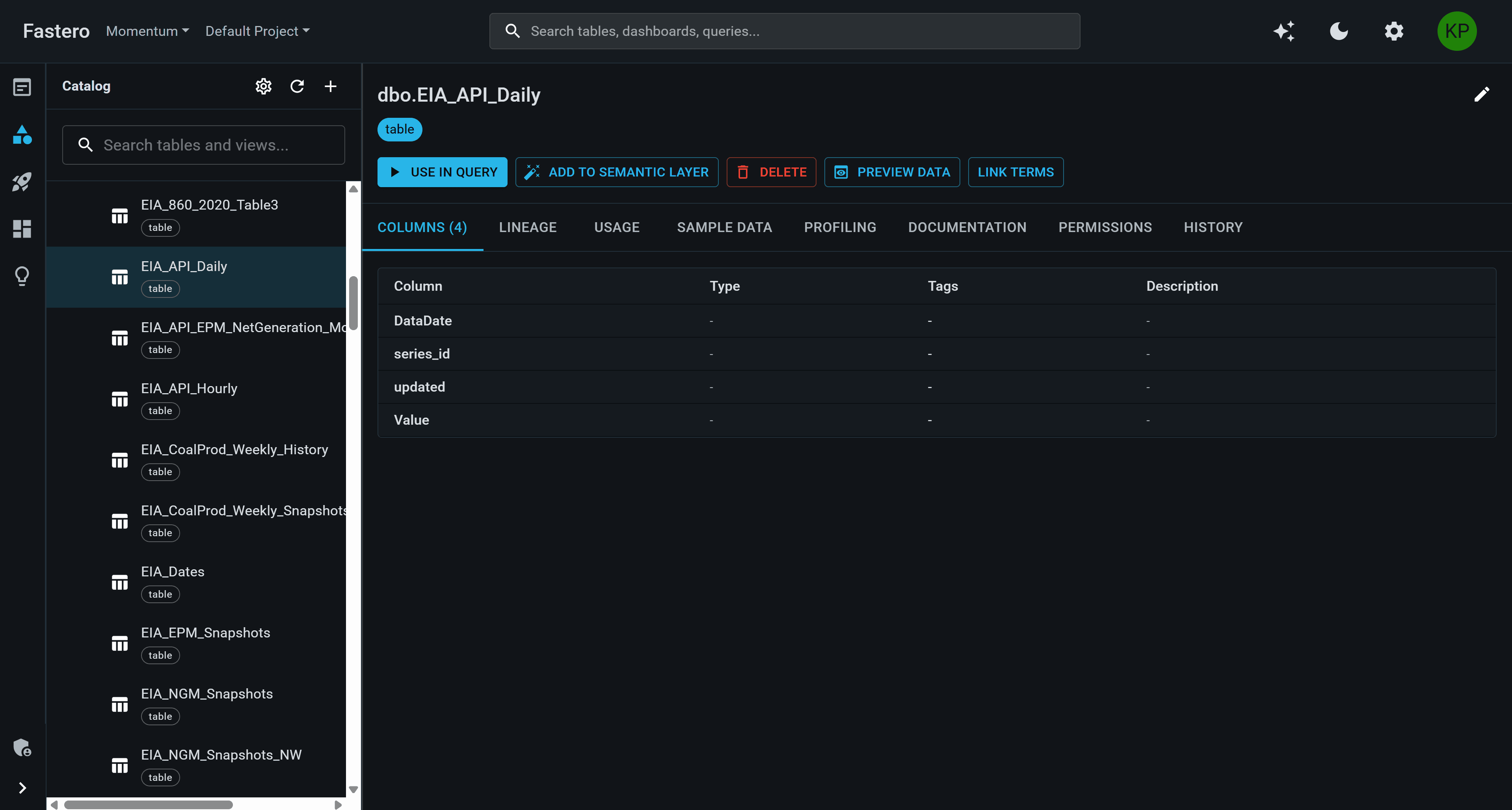Data Fabric
One catalog for tables, queries, notebooks, and APIs. Auto-discover assets, define metrics once, and track lineage—without months of setup.

Unified catalog for tables, queries, dashboards, notebooks, and APIs—all searchable in one place
Everything in one catalog
Search across all data assets—tables, queries, notebooks, dashboards, and APIs. No more tribal knowledge or siloed documentation.
Unified Search
Find tables, queries, notebooks, dashboards, and APIs in one search. Filter by type, owner, tags, or data source.
Tag-Based Organization
Organize assets with tags: [pii], [production], [deprecated], [finance]. Find what matters fast.
Rich Metadata
Store descriptions, owners, domains, schema details, and sample data. Everything your team needs to understand an asset.
Automatic Lineage
Track dependencies passively. See which dashboards, APIs, and workflows use each table or query—no manual docs needed.
Multi-Warehouse Support
Catalog assets from Snowflake, BigQuery, Databricks, Redshift, and more—all in one unified view.
dbt Integration
Import dbt manifests automatically. Sync models, tests, and documentation into the catalog without manual work.
Trust your metrics
Define canonical business metrics once. Enforce them everywhere—queries, dashboards, APIs. No more 'which revenue number is right?'
Semantic Layer
Define metrics like 'revenue,' 'active users,' and 'churn rate' once. Reference them in queries, dashboards, and APIs with consistent logic.
Business Glossary
Store plain-English definitions for business terms. Align technical and non-technical teams on what metrics mean.
Metric Validation
Test metric logic before deploying. Preview results, validate SQL syntax, and ensure correctness.
Version Control
Catalog definitions are Git-versioned. Track changes, review updates, and roll back if needed—just like code.
Semantic Metric Definition
monthly_revenue
Total revenue excluding refunds and discounts
SELECT
DATE_TRUNC('month', created_at) AS month,
SUM(amount) - SUM(refund_amount) - SUM(discount) AS revenue
FROM orders_table
WHERE status = 'completed'
GROUP BY 1Used By
- revenue_dashboard (234 views)
- finance_api (1.2k requests/day)
- monthly_report (scheduled)
Know who uses what before you break it
Automatic lineage tracking shows you exactly which dashboards, APIs, and workflows depend on each asset. No manual documentation needed.
Upstream Sources
See which tables, connections, and raw data sources feed into a query or notebook. Trace data back to its origin.
Downstream Consumers
Identify which dashboards, reports, APIs, and workflows use this asset. Assess blast radius before making changes.
Change Impact Preview
Before promoting to production, see exactly what will be affected. Lineage data helps you avoid breaking production workflows.
Cross-Asset Dependencies
Track dependencies across asset types: table → query → dashboard → API. Full end-to-end visibility.
Audit Trail
Every catalog change is logged. See who updated metadata, changed tags, or modified descriptions—with timestamps.
Git-Versioned Catalog
Catalog definitions stored in Git. Review changes via PR, roll back mistakes, and keep catalog in sync with code.
How teams use Data Fabric
Analytics Engineering
Centralize metric definitions
Define canonical business metrics in the semantic layer. Ensure 'revenue,' 'active users,' and 'churn' mean the same thing across every query, dashboard, and report.
Data Governance
Track sensitive data usage
Tag PII and sensitive tables. See which queries and dashboards access them. Enforce access policies and maintain compliance audit trails.
Business Analysts
Find trusted data sources
Search the catalog for 'customer,' 'revenue,' or 'orders.' No more asking in Slack or digging through undocumented tables.
Common questions
How does the catalog populate?
Fastero auto-discovers assets when you connect data warehouses (Snowflake, BigQuery, etc.). It also catalogs queries, notebooks, and dashboards you create in the workbench. Optionally, enrich assets with tags, descriptions, and owners.
Can I import my dbt project?
Yes! Connect your Git repo or upload a dbt manifest (target/manifest.json). Fastero will import models, tests, column descriptions, and tags automatically. You can also sync on every Git push.
Does this replace our data catalog?
It depends. If you use Atlan/Alation/Collibra for governance workflows and data stewardship, Fastero complements them. If you only use a catalog for discovery and lineage, Fastero can replace it—with the added benefit of an operational semantic layer.
What's the difference between catalog and semantic layer?
The catalog is the inventory (what assets exist, who owns them, where they live). The semantic layer defines business logic (how to calculate 'revenue,' 'churn,' etc.). Together, they ensure your team finds the right data and uses it consistently.
Do you support Apache Iceberg?
You can connect to Iceberg tables via Snowflake or Databricks. First-class Iceberg REST catalog integration (time travel, schema evolution tracking) is planned for Q1 2025.
Can I see a visual lineage graph?
Lineage data is tracked automatically, but the interactive graph UI is on the roadmap for Q1 2025. Currently, lineage is shown as a list of upstream sources and downstream consumers.
Ready to unify your data catalog?
Start a 30-day trial and see how Data Fabric helps your team find data faster, trust metrics more, and avoid breaking production.